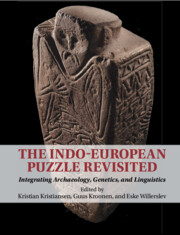Book contents
- The Indo-European Puzzle Revisited
- The Indo-European Puzzle Revisited
- Copyright page
- Contents
- Figures
- Tables
- Contributors
- Preface
- Introduction
- Part I Early Indo-European and the Origin of Pastoralism
- Part II Migratory Processes and Linguistic Dispersals between Yamnaya and the Corded Ware
- Part III The Cultural and Linguistic Significance of Bell Beakers along the Atlantic Fringe
- Part IV The Bronze Age Chariot and Wool Horizons
- 14 Relative and Absolute Chronologies of the Chariot Complex in Northern Eurasia and Early Indo-European Migrations
- 15 Indo-European and Indo-Iranian Wagon Terminology and the Date of the Indo-Iranian Split
- 16 Fire and Water: The Bronze Age of the Southern Urals and the Rigveda
- 17 Wool Fibers of the Northern Eurasian Bronze Age: The Cultural and Geographical Contexts
- 18 An Archaeolinguistic Approach to Indo-European Wool Terminology
- Part V Kinship Systems, Marriage, Fosterage, Free, and Unfree
- Concluding Reflections
- Index
- References
15 - Indo-European and Indo-Iranian Wagon Terminology and the Date of the Indo-Iranian Split
from Part IV - The Bronze Age Chariot and Wool Horizons
Published online by Cambridge University Press: 29 April 2023
- The Indo-European Puzzle Revisited
- The Indo-European Puzzle Revisited
- Copyright page
- Contents
- Figures
- Tables
- Contributors
- Preface
- Introduction
- Part I Early Indo-European and the Origin of Pastoralism
- Part II Migratory Processes and Linguistic Dispersals between Yamnaya and the Corded Ware
- Part III The Cultural and Linguistic Significance of Bell Beakers along the Atlantic Fringe
- Part IV The Bronze Age Chariot and Wool Horizons
- 14 Relative and Absolute Chronologies of the Chariot Complex in Northern Eurasia and Early Indo-European Migrations
- 15 Indo-European and Indo-Iranian Wagon Terminology and the Date of the Indo-Iranian Split
- 16 Fire and Water: The Bronze Age of the Southern Urals and the Rigveda
- 17 Wool Fibers of the Northern Eurasian Bronze Age: The Cultural and Geographical Contexts
- 18 An Archaeolinguistic Approach to Indo-European Wool Terminology
- Part V Kinship Systems, Marriage, Fosterage, Free, and Unfree
- Concluding Reflections
- Index
- References
Summary
In the literature (e.g., Anthony 2007: 35–37), it is often stated that we can reconstruct five words of wheel and wagon terminology for Proto-Indo-European (PIE), viz. the words for ‘wheel’ (2×), ‘axle’, ‘thill’, and the verb ‘to convey in a vehicle’
Information
- Type
- Chapter
- Information
- The Indo-European Puzzle RevisitedIntegrating Archaeology, Genetics, and Linguistics, pp. 257 - 262Publisher: Cambridge University PressPrint publication year: 2023
References
Accessibility standard: Unknown
Why this information is here
This section outlines the accessibility features of this content - including support for screen readers, full keyboard navigation and high-contrast display options. This may not be relevant for you.Accessibility Information
- 1
- Cited by
